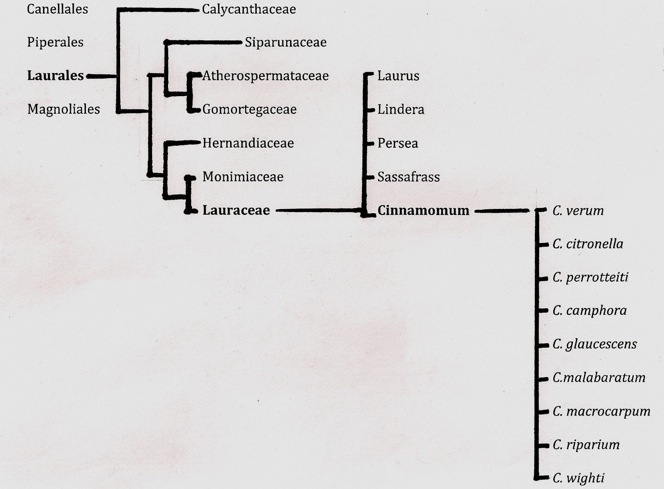Phylogeny
Seen below is the phylogenetic tree that was based on the classification of Cinnamomum zeylanicum (which is actually under C. verum, a synonym for C. zeylanicum). This phylogenetic tree was based primary on morphological characteristics, such as tracheophyta, meaning plants with vascular tissue and spermatophyta, meaning plants with seeds.
 The first picture shows classification from the domain Plantae up to the class Magnoliopsida. The second picture below takes a more closer look at the order, family, genus, and other species related to cinnamon. Some organisms that share the same family include the avocado (Persea), Sassafras (Sassafrass), and Bay Laurel (Laurus). This tree also shows other closely related species. Similar species also belong to the genus Cinnamomum. Some of these include: C. camphora, C. riparium, C. cassia, C. citronella, C. perrotteiti, and others seen below.
The first picture shows classification from the domain Plantae up to the class Magnoliopsida. The second picture below takes a more closer look at the order, family, genus, and other species related to cinnamon. Some organisms that share the same family include the avocado (Persea), Sassafras (Sassafrass), and Bay Laurel (Laurus). This tree also shows other closely related species. Similar species also belong to the genus Cinnamomum. Some of these include: C. camphora, C. riparium, C. cassia, C. citronella, C. perrotteiti, and others seen below.


If you are interested in similar species you can check out other multiple organisms webpages:
-
‣Helianthus annus, the sunflower shares the same class with cinnamon.
-
‣Medicago sativa, alfalfa also shares the same class with cinnamon.
-
‣Solanum tuberosum, potato shares the same class with cinnamon.
-
‣Mentha x piperita, peppermint
-
‣Asarum canadense, Canadian wild ginger
-
‣Castanea dentata, chesnut
